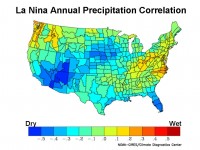By Joseph D’Aleo, CCM
While the networks and some politicians are implying global warming is to blame for the fires in the southwest, the unfortunate fires can be explained very nicely by natural factors. La Ninas are more frequent when the Pacific Decadal Oscillation is in its cold phase (see this blog). The Pacific was in that phase from 1947 to 1977 and then briefly from 1998 to 2001 (with 3 of 4 years in La Nina). It has returned back to the cold phase in recent months and a moderate La Nina has ensued.
You can see clearly from the following correlation chart of La Ninas (using the Southern Oscillation Index) with precipitation from CDC, that La Ninas favor dryness in the southwest.

The cooling in the Pacific caused the past El Nino winter (2006/07) rains to fail in California. That means the region has undergone drought for 18 months. This combined with unwise policy that Dr. Scott Campbell reported on yesterday concerning the prohibition against clearing up accumulated brush from the areas surrounding housing developments that were instituted at the insistence of the Sierra Club and other environmental groups has left more fuel for the fires fanned by the Santa Ana winds, which as Dr Patzert indicated, in a recent linked to release, were also more common in La Ninas.
A few years back McCabe, Palecki and Betancourt published a paper that looked at drought frequency across the United States related to both the Pacific Decadal Oscillation and the Atlantic Mulitdecadal Oscillation. Droughts in the United States were more frequent when the Atlantic was in its warm mode. When the Atlantic was warm, and the Pacific was also in its warm mode, the dryness was more across the northwest and southeast and when the Pacific was cold more across the southwest. We are currently in the warm Atlantic and cold Pacific mode and thus should expect the dryness in the southwest. See these maps and read more here.




